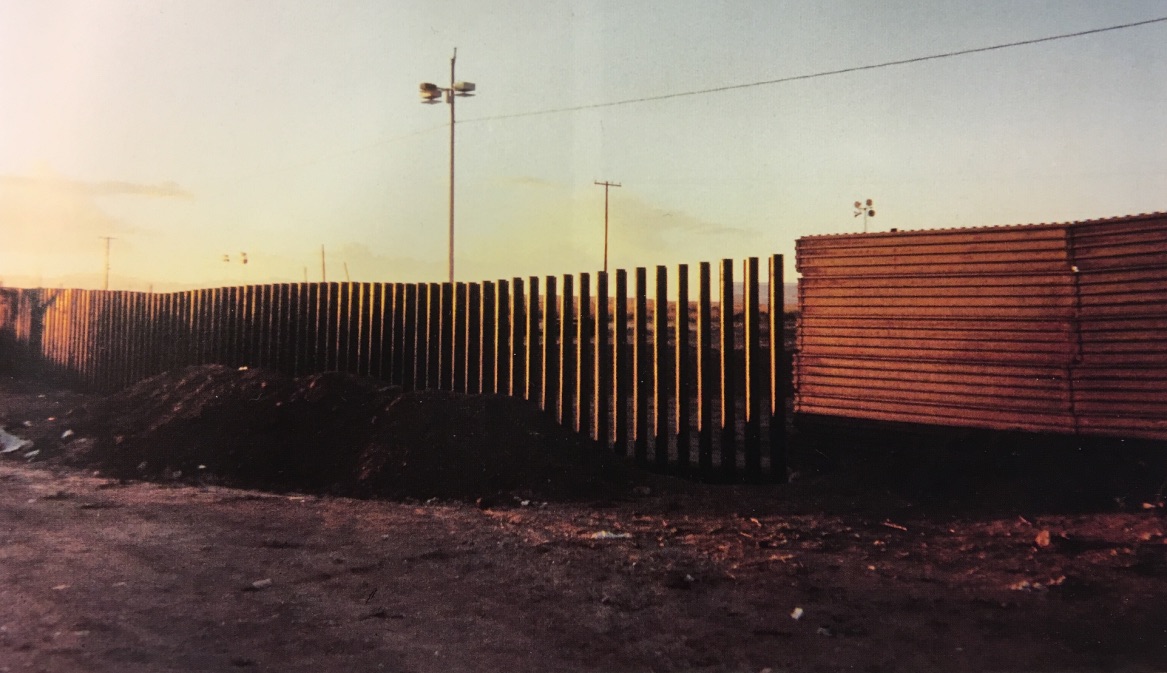1.
In 2016 Icarus Films released a beautiful DVD set including four of Chantal Akerman’s documentaries: D’Est [From the East] (1993), Sud [South] (1999), De l’autre côté: Une voix dans le désert [From the other side: A voice in the desert] (2002) and Là-bas [Over There] (2006). Choosing titles as if to cover all possible compass points, Akerman indeed travelled far to retrace other people’s journeys and stories, decisively though instinctively. De l’autre côté, which I will be looking into, is Akerman’s careful exploration of the lives of Mexican migrants at the US border. Set in the frontier towns of Agua Prieta and Douglas, De l’autre côté has the Mexican-American border fence as its spine. A highly visual, tactile though alien entity taking differing shapes — now corrugated plates, then iron bars or piled up barbed wire — the fence pierces through the stories at both of its sides. On the Mexican side, Akerman captures the testimonies of a grandmother, a husband, a brother, a son and a group of refugees. On the American side, we meet an Arizonian couple, a local sheriff, an ambassador and a restaurant owner. This last one is portrayed in his restaurant in a stunning hidden camera-like scene, as if we are witnessing what shouldn’t be witnessed, listening to someone’s blunt prejudices and fear. Sometimes you feel like you shouldn’t be there, but then Akerman’s confident voice drops in, reassuring you somehow that the camera is exactly where it should be. Intersecting these interviews and testimonies is the story of a Mexican middle-aged housekeeper who suddenly disappeared, which Akerman narrates herself in a recurring voice-over. In the very last scene, a long traveling shot of a Los-Angeles highway by night, Akerman concludesAll quotations from Chantal Akerman were translated from French by the author.: “Anyway, a little later she went. I wonder whether she is in Mexico or some place else. Sometimes I tell myself she is dead. But that’s just these dark ideas I have. She’s not dead. She is in Mexico or elsewhere, I can’t tell where. I never saw her again.” It is a haunting testimony — and it turns out to be fictional.
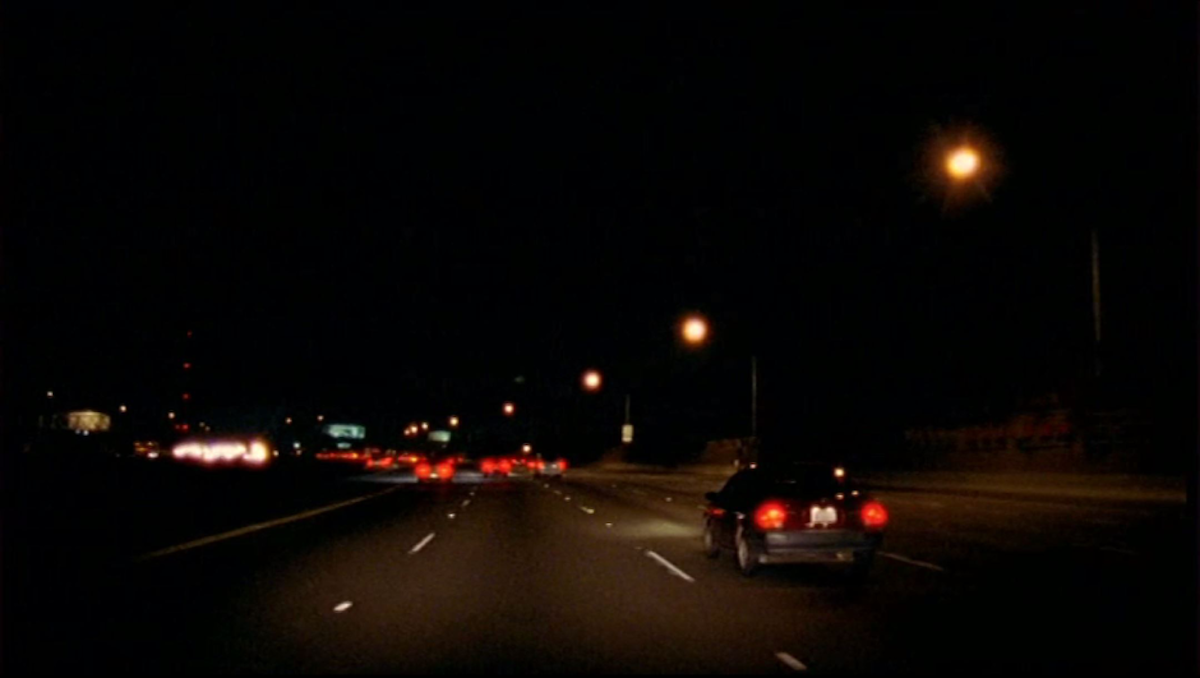
2.
At a screening of the film on May 3rd, 2012 in New York, Akerman told the audience that the concluding anecdote of De l’autre côté is entirely fictional. “It’s totally fictional but it could have been true,” she said. “There is not such a wall between documentary and fiction” she added, “It can be porous.”
Interestingly, in her essay book Autoportrait en cinéaste (2004) she writes something similar: “If after filming and editing a documentary doesn’t open up a breach to the imaginary, if it doesn’t slip into fiction, then for me, it is not a documentary. In regard to a fiction film, if it does not slip into documentary, then I have a hard time believing it is a fiction film.”
How then can we understand this ‘slipping into fiction’, which is not coincidently referenced in the subtitle of D’Est: Au bord de la fiction (on the edge of fiction)? Apparently, a story can be as truthful when extracted from a documentary source as when created as fiction. It can be a folk tale or an anecdote, a personal memory or a testimony. The point is, in Akerman’s poetics it somehow does not make much of a difference. Something else is at stake.
3.
If I would let myself go, I would stay in front of these phone booths and I would film and register all the things these people have to say to their families in their hometowns. If I would let myself go, I would look up all the names of all the people that died in the desert, unscrupulously. And their traces too. And also, whose father or mother they were, whose son or daughter. And then, the exact location where they died.Autoportrait en cinéaste, 93f.
Akerman expressed that she wants to engage in a certain socio-historical situation “à l’aveuglette” [blindly] or like some kind of “éponge-plaque sensible” [sponge/negative plate], not to let go until she has covered it fully. She does not want to ‘pre-think’ a situation but wants to find a state of mind where one is restrained to judge and inclined to perceive reality as if for the first time. This is what makes her practice different from that of political filmmakers: “They have a skeleton, an idea and then they put on flesh: I have in the first place the flesh, the skeleton appears later.”Akerman quoted by Ivone Margulies, Nothing Happens (1996), 42. An explanation for Akerman’s encyclopaedical aesthetics and materialist approach — in short: her urge for a well-documented filmmaking — is to be found in more than just her passion to portray the unseen, the everyday or the uncinematic (the often discussed themes of dead time, boredom or domestic work). It seems to arise out of a moral compulsion with showing, or at least knowing, everything.
Whether it is the scanning of clothes, train stations and private interiors in D’Est, the texture of the endlessly filmed road where a man was tortured to death in Sud or the incredible tactility of the vertical blinds and other scarce objects in the filmmaker’s apartment in Là-bas (not to mention the sudden importance of any registered activity of the neighbors filmed through these blinds): in every one of these films, details are not mere details. In the frontally framed interview with the Mexican grandmother Delfina Moruni Miranda in De l’autre côté, the spectator’s eye is guided to the glimmering plastic tablecloth, to the television that reflects the off-space behind us and the bandage on her right forearm. The tactile elements in this beautifully composed mise-en-scène once again testify to the directors’ obsession with materiality and detail, her “passion for the appropriate” — to echo Bresson’s Notes on the Cinematograph. If she would let herself go, she would film everything.
But again, can we harmonize this commitment to material detail and precise historical evidence with the simultaneous presence of testimonies that are de facto fabricated, fictional?
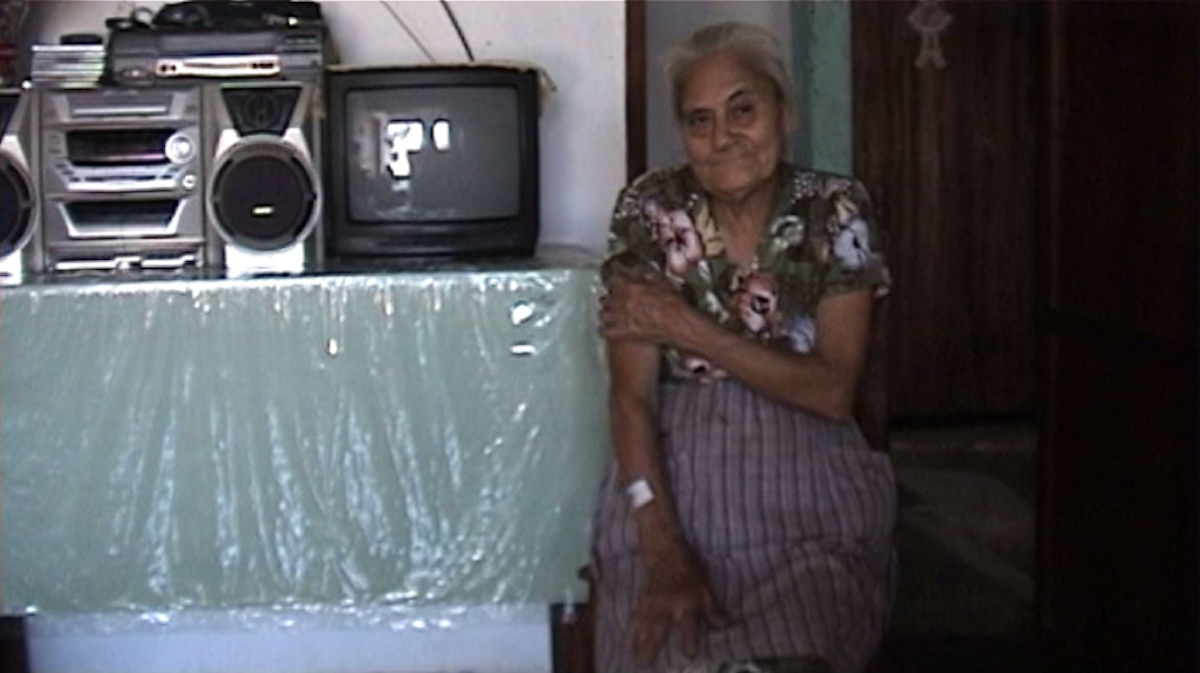
4.
The answer is yes — if we look at Akerman’s work from a classical realist point of view. My hypothesis would then be that Akerman shares much of her aesthetic ideal of storytelling and her cinematographic interfering with ‘objective’ reality, with the Hungarian Marxist and literature theorist Georg Lukács, in more than one way. Lukács admired realist writers for their thorough depiction of “a limited section of reality, however richly portrayed” as well as for their capacity to link back the particular traits of the portrayed individual to the whole of society, in other words, to mediate between the particular/the accidental and what he termed ‘social totality’. “In the works of a great realist everything is linked up with everything else”, he writes. “Each phenomenon shows the polyphony of many components, the intertwinement of the individual and social, of the physical and the psychical, of private interest and public affairs.”Studies in European Realism (1950), 145. Interesting now, is that Lukács not only values detail as much as Akerman, but also argues that documentary fact and an author’s own creation unproblematically accord in the quest for a truthful image of reality: “The detail in a work of art is an accurate reflection of life when it is a necessary aspect of the accurate reflection of the total process of objective reality, no matter whether it was observed by the artist in life or created through imagination out of direct or indirect experience.”Art and Objective Truth (1954), 43.
5.
Echoing Lukács’s belief that a realist work of art is able to “penetrate into the small details of everyday life” and that “it must bring out what is specific to this time through the complex interaction of all these details”, Akerman too puts her trust in detail to bring out what is specific. Especially her documentary work has this astonishing capacity to zoom in on what is singular, particular, sometimes very personal too, and at the same time what is unescapably universal. For example, in the second half of De l’autre côté, Akerman portrays an Arizona border sheriff by the name of Larry A. Dever in a balanced tableau shot, with every single element in the frame adding to his narrativization: a truck on the left, a stagecoach on the right, his nameplate and his shiny leather jacket, the blue cup, the computer, the badge of honour on the wall, a stuffed eagle in the right corner, … Larry A. Dever is as typical as he is individual. Sitting there confidently, on the central axis of the frame, he could be any South-western town’s sheriff. His particular individual traits, Lukács would argue, are combined with the typical traits of a character of his class. Something similar could be said of the nameless teenage boy narrating his family’s failed escape attempt. When his testimony is followed by a nighttime scene showing a helicopter scanning the dunes for trespassers, both the testimony and the nocturnal scene are charged with a feeling of ‘essence’. It could be other people getting caught on that moment, unwillingly repeating the boy’s story. Running, hiding, seeking shelter are depicted in so many tenses; past, present, future, singular, universal and personal.
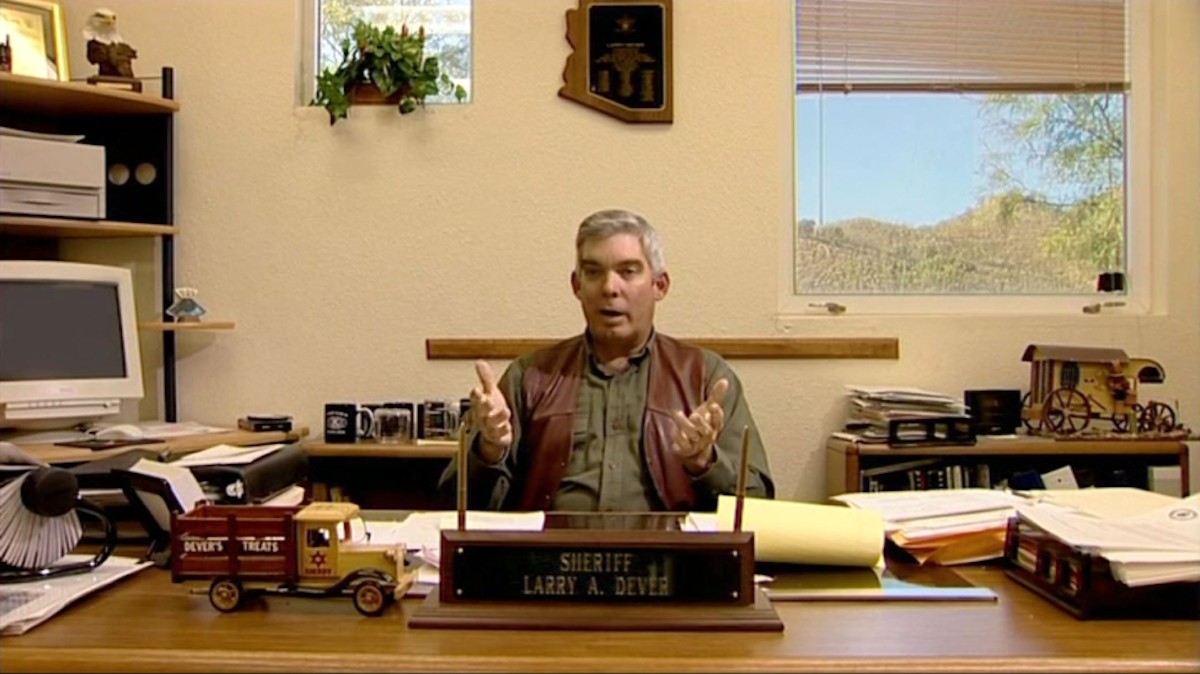
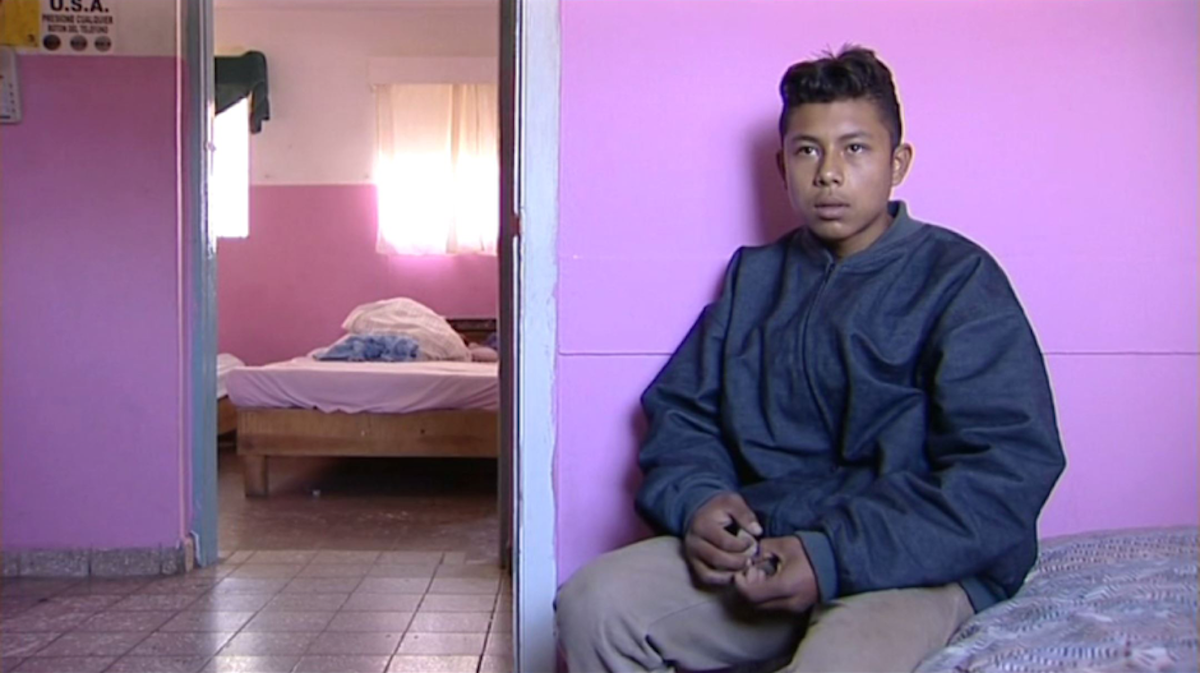
6.
“These faces of D’Est, I knew them, they made me think of other faces.”Autoportrait en cinéaste, 42.
Akerman once said that the people queuing for a bus in the freezing cold in D’Est can impossibly be disconnected from the concentration camps. In Akerman’s films, these ‘tenses’ of suffering and injustice are often to be traced back to questions of Jewish identity and trauma — even, or especially, in the films that do not directly address the topic. As D’Est shows, waiting after the Holocaust can never be mere waiting again. In conversation with Cahiers, Akerman explains that the idea for making De l’autre côté came from the word ‘dirt’:
Originally, the project wasn’t linked to the idea of the border but to a word. I had read an article about American ranchers chasing illegals by night with magnum guns and night vision goggles. They said that the Mexicans brought dirt with them. It was this word, ‘dirt’. Immediately, I had to think of ‘dirty Jews’, ‘dirty Arab’, …Cahiers du cinéma, n. 574.
There are eternal categories of injustice and not-belonging that, in order to oppose them, ask for a hybrid form of storytelling beyond genres and across all media. In confronting these discourses, whether white supremacism in Sud, structural violence against migrants in De l’autre côté or degrading stereotypes about the East in D’Est, Akerman finds a language that reunites the autobiographical and the universal, the present and the past — and indeed: the fictional and the non-fictional.
7.
Although there is “really nothing to say about her”, in the final voice-over Akerman tells us a lot more about the vanished Mexican woman:
There is really nothing to say about her. Every day, she left and came back around the same time. She hardly went out again. Except on Sundays, she must have gone to the beach, I think. Because on Sundays there was always a little sand on the stairs. Sometimes she went out to smoke. I don’t like when people smoke inside. She’d wander down the block, smoking, thinking. About what? That I can’t tell you. (…) I wonder whether she is in Mexico or some place else. Sometimes I tell myself she is dead. But that’s just the dark ideas I have. She’s not dead. She is in Mexico or elsewhere but I can’t say where. I never saw her again. Well, once I thought I did… But I’m not sure it was her… it wasn’t far from here… on the corner of the street, and the boulevard. There are a lot of Mexicans there. I was in the car, and when I got there, no one was there. It must have been a hallucination.
This final character is the filmmaker’s construction; nevertheless, she has an impact on us. This character is a single voice in the desert and yet enables many other voices to resonate. She is a person of ‘dissensus’, to say it with Jacques Rancière, in between worlds, never resting or agreeing, nor answering to the logic of representation or fictional invention, always on the move in between time and space, always deconstructing, creating a space to reimagine an absent history. She wanders in between real and fictional worlds as if to challenge history and to bring to the fore a new temporality of memory and narration. Paul Ricoeur once wrote: “fiction (…) permits historiography to live up to the task of memory; victims whose suffering cries less for vengeance than for narration.” Rancière in turn wrote that “the real must be fictionalized in order to be thought” and that therefore fictions are always already a matter of politics. Three decades before him, Akerman already knew that one has to stage life in order to grasp it, il faut mettre en scène la vieAkerman quoted by Eric De Kuyper, Versus (1983), 15..
8.
This Mexican woman — ironing, listening to the radio, smoking inside her apartment, wandering around the block, going to the seaside and leaving sand on the stairs — doesn’t differ from Delfina Miranda or the sheriff, the racist restaurant owner or the boy with no name, precisely in this abundance of detail. Whether Akerman’s ‘real’ characters get narrativized or her fictional ones get ‘documentarized’, is secondary to the fact that both ‘kinds’ enter a twilight zone: that is, being unique and carefully portrayed, while at the same time capable of representing a collectivity. Her characters both are intrinsically themselves and reflect other people in other contexts too.
This is how we should understand Akerman’s “there is not such a wall between documentary and fiction”. It is also in this way that her modernism and realism collide: a realist trust in materiality that is essentially formalist. Marked by a simultaneous presence of structure and contingency, Akerman’s poetics allows an interplay of what was found and what was invented, to eventually get to the essence of how things are in relation to each other, both in time and space. Lukács is of use here to understand Akerman’s historical thinking and her confidence to gradually find, through art, a truthful understanding of reality by drawing on the most varied sources: personal, universal, past, present and fictional. All these sources work together in coming to an understanding of this world — they allow us to see connections and can get to the core of things instead of merely describing them in a naturalistic way. De l’autre côté: Une voix dans le désert (2002) turned fifteen last year, but its stories are as present as ever.
